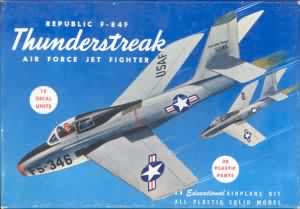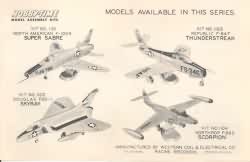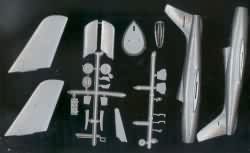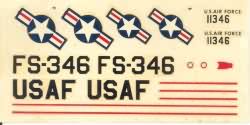HOBBY-TIME kit No. 1103:49 Republic F-84F Thunderstreak |  |  A division of Western Coil & Electric Company (Racine, Wisconsin), HOBBY-TIME began kit production in the late 1940s with a small line of solid scale (non-flying) balsa models, some of which were featured in previous 'Kit Corners'. These models each contained a few plastic parts, mainly the display stand and canopy, but sometime in the 1950s production was switched to all-plastic kits. The first was a 1/43 scale Bell XV-3, followed by a WWII fighter series consisting of a 1/81 scale P-47D bubbletop, 1/73 Spitfire II, 1/66 Me-109F, and 1/74 P-51D; these last four were later reissued by Lindberg and were available in that guise for many years, the P-51 unbelievably being the most accurate late model Mustang available in anything near 1/72 scale for many, many years until the appearance of the Matchbox kit. A second series of four kits featured a 1/71 scale F-100A, 1/67 F4D-1, this F-84F in 1/68 scale, and a 1/123 F-89D. The final series was a collection of small-scale bombers - 1/242 B-29, 1/133 B-25J, 1/181 B-24J, and 1/127 A-26. All three of these series, a total of twelve kits, used an identical box size thus the varying scales - a common practice of the day in the US as opposed to the constant 1/72 scale used virtually from the beginning in the UK. HOBBY-TIME also released three flying 'scale' models in approximately 1/48 scale - another F4D-1 and an F-100A to keep their smaller siblings company, and an F3H-1 Demon. Production apparently ceased during the late 60s, with most of the all-plastic kits later being reboxed in Costa Rica by Plasticos Star in the late 80s. A division of Western Coil & Electric Company (Racine, Wisconsin), HOBBY-TIME began kit production in the late 1940s with a small line of solid scale (non-flying) balsa models, some of which were featured in previous 'Kit Corners'. These models each contained a few plastic parts, mainly the display stand and canopy, but sometime in the 1950s production was switched to all-plastic kits. The first was a 1/43 scale Bell XV-3, followed by a WWII fighter series consisting of a 1/81 scale P-47D bubbletop, 1/73 Spitfire II, 1/66 Me-109F, and 1/74 P-51D; these last four were later reissued by Lindberg and were available in that guise for many years, the P-51 unbelievably being the most accurate late model Mustang available in anything near 1/72 scale for many, many years until the appearance of the Matchbox kit. A second series of four kits featured a 1/71 scale F-100A, 1/67 F4D-1, this F-84F in 1/68 scale, and a 1/123 F-89D. The final series was a collection of small-scale bombers - 1/242 B-29, 1/133 B-25J, 1/181 B-24J, and 1/127 A-26. All three of these series, a total of twelve kits, used an identical box size thus the varying scales - a common practice of the day in the US as opposed to the constant 1/72 scale used virtually from the beginning in the UK. HOBBY-TIME also released three flying 'scale' models in approximately 1/48 scale - another F4D-1 and an F-100A to keep their smaller siblings company, and an F3H-1 Demon. Production apparently ceased during the late 60s, with most of the all-plastic kits later being reboxed in Costa Rica by Plasticos Star in the late 80s.
 I have a number of the HOBBY-TIME kits and their F-84F is representative of all of them. It's extremely basic and somewhat chunky. Crude landing gear is included but the gear wells are merely raised outlines under the nose and on the bottom of the wings. Cockpit 'detail' consists of a pilot's head and shoulders displayed under an overly-thick clear canopy - the rear view windows are molded into the fuselage halves and indicated by raised outlines. The nose inlet is a separate piece blanked off about 1/8 inch deep and features a mounting for the test probe on the upper port quadrant - very curious since the probe on the actual aircraft was mounted on the center of the intake splitter. As is usual for the era of modeling represented, there's nothing in the exhaust opening to prevent seeing inside the model all the way to the front of the airplane. Surface detail consists of heavy raised lines, including all control surfaces but thankfully omitting the often-seen outlines used in old kits to assist the builder in locating the decals. Instructions are a single page I have a number of the HOBBY-TIME kits and their F-84F is representative of all of them. It's extremely basic and somewhat chunky. Crude landing gear is included but the gear wells are merely raised outlines under the nose and on the bottom of the wings. Cockpit 'detail' consists of a pilot's head and shoulders displayed under an overly-thick clear canopy - the rear view windows are molded into the fuselage halves and indicated by raised outlines. The nose inlet is a separate piece blanked off about 1/8 inch deep and features a mounting for the test probe on the upper port quadrant - very curious since the probe on the actual aircraft was mounted on the center of the intake splitter. As is usual for the era of modeling represented, there's nothing in the exhaust opening to prevent seeing inside the model all the way to the front of the airplane. Surface detail consists of heavy raised lines, including all control surfaces but thankfully omitting the often-seen outlines used in old kits to assist the builder in locating the decals. Instructions are a single page  with an exploded drawing of the kit's 28 parts with a numbered assembly sequence splashed around seemingly at random. Basic painting suggestions are provided along with an admonition to use enamel rather than lacquer-based paint. Another helpful tip suggests that carbon tetrachloride can be used as a substitute for plastic cement, a commodity that was not widely available in the early days of plastic kits. with an exploded drawing of the kit's 28 parts with a numbered assembly sequence splashed around seemingly at random. Basic painting suggestions are provided along with an admonition to use enamel rather than lacquer-based paint. Another helpful tip suggests that carbon tetrachloride can be used as a substitute for plastic cement, a commodity that was not widely available in the early days of plastic kits.
A fairly comprehensive decal sheet is included for an aircraft in what is basically a simple delivery scheme - no unit badges or other colorful markings common in the  1950s are provided. The lettering, numbers, and striping look okay but the national insignia is ill-proportioned and its red stripes are out of register. Surprisingly the decals don't show any sign of cracking, seem to be very thin, and there is very little discoloration of the clear carrier film - they could probably be used after being bleached out in sunlight for a few days. 1950s are provided. The lettering, numbers, and striping look okay but the national insignia is ill-proportioned and its red stripes are out of register. Surprisingly the decals don't show any sign of cracking, seem to be very thin, and there is very little discoloration of the clear carrier film - they could probably be used after being bleached out in sunlight for a few days. This kit is slated for a nostalgia-style build gear-up on its stand so I test fitted the major parts; it's going to require quite a bit of trimming and reworking - the wing chord is greater than the length of the wing roots molded into the fuselage and neither the wings or horizontal tailplanes are a very good fit. The canopy is an especially poor fit. I'll probably preserve the raised detail to maintain the kit's old-time appearance but will rescribe the control surface and gear well outlines as a sop to my sense of scale fidelity. Given the amount of work that's going to be required just to get a decent fit this kit must have been a real challenge for a youngster! John Burns' PAK-20 gives a value of $8-12 but I got mine off eBay at less than that including postage so I suspect that it would go for considerably less at a swap meet. If you're looking for a realistic F-84F model this isn't the one for you but it's an interesting slice of history for the collector. Until next month, "Build what YOU like, the way YOU want to", have fun, and be sure to visit Al's Place while you're surfing the 'Net! |
|
